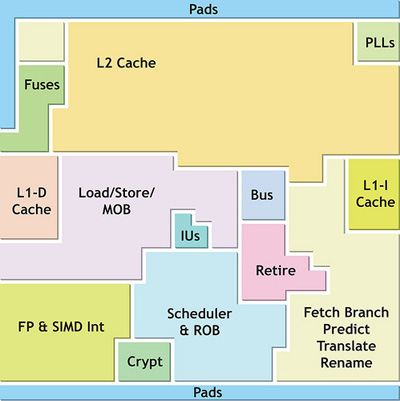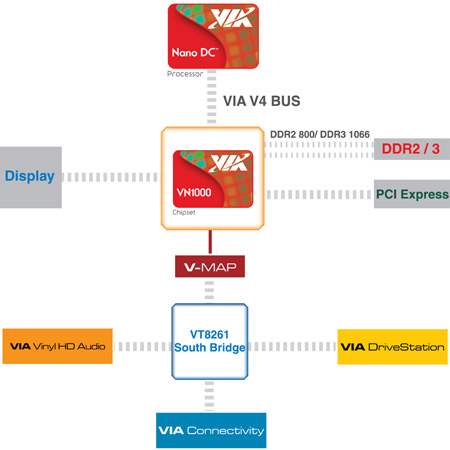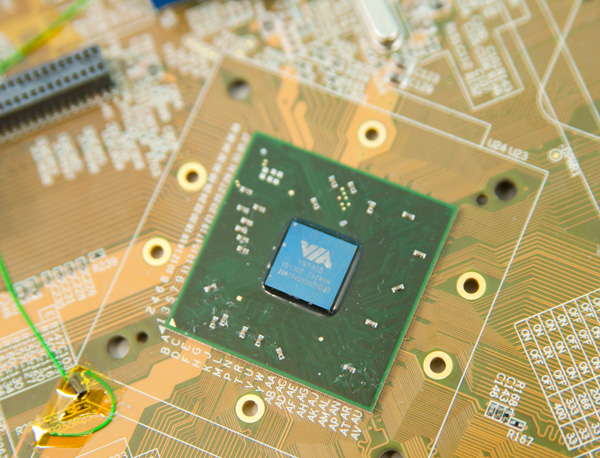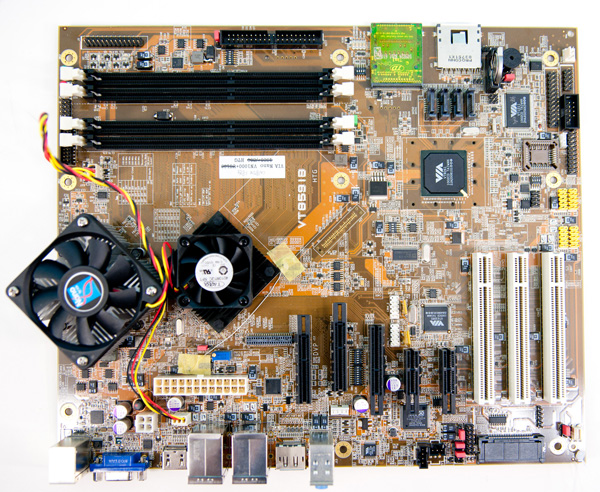VIA's Dual Core Nano & VN1000 Chipset Previewed
by Anand Lal Shimpi on November 15, 2010 12:26 PM ESTI haven’t had an official product briefing with VIA in years. The last time I met with a representative from the company was two years ago outside of IDF in San Francisco. Before then, it was probably around 4 years.
VIA was the first casualty of integration in the PC space. Today we’re all talking about moving graphics onto the processor die, but a few years ago we were having similar discussions about moving the memory controller and north bridge on die. As a manufacturer of chipsets (north and south bridges) for CPUs, VIA lost relevance in the x86 CPU market as the need for a third party chipset maker faded.
VIA’s recent visit to me in Raleigh, NC had two purposes according to the company. One, to remind me that VIA was still around and to give me some face to face time with a VIA representative (appreciated). And two, to showcase VIA’s dual-core Nano platform and brand new integrated graphics chipset (intriguing).
For those of you who don’t know, Nano is VIA’s answer to Atom, except it came along long before Atom did. Just like Atom, Nano was designed in Texas but by VIA’s Centaur team - a microprocessor company it acquired several years back. Centaur’s speciality was low power microarchitectures, and Nano is exactly that.

Compared to Atom, Nano is a bit of a beast. Both Atom and AMD’s Bobat core can fetch and issue up to two instructions. Nano can do three. Like AMD’s Bobcat, Nano has a full out of order execution engine. Atom, for the time being, is in-order.
The execution engine is well matched to the front end. Nano features seven dispatch ports and can retire up to three instructions per clock. In this sense, Nano is more like AMD’s Bobcat than Intel’s Atom. In fact, those two should be better matched than Atom vs. Nano.

VIA's Nano
Nano has other advantages over Atom. It features a hardware encryption engine. Something VIA introduced long before Intel’s AES-NI in Westmere. All of these features come at the expense of power consumption. Nano should be faster, but it draws more power than Atom.
VIA is a fabless semiconductor manufacturer, its Nano processor and associated chipset are both fabbed at TSMC in Taiwan. Nano is currently a 65nm design although VIA plans to take it to 40nm in 2011.
The dual-core Nano that VIA dropped off is architecturally identical to the existing Nano. Similar to the dual-core CPUs, DC Nano is literally two Nano die placed alongside one another. The L2 caches are private and all core-to-core communication happens externally via the Nano’s latest chipset: VIA’s VN1000. The dual-core die measures 8.5 mm x 16 mm (136mm^2 total area) on a 21 mm x 21 mm BGA package.
Ironically enough, VIA hasn’t integrated a memory controller into its own CPU design. Although to VIA’s credit, the CPU’s performance is competitive without it. I suspect VIA will deliver a more integrated version of Nano within the next 12 - 18 months.
While the dual core Nano improves competitiveness with Intel’s Atom, it’s the VN1000 that’s a huge step forward. These days everyone is talking about graphics and VIA is no exception. The VN1000 integrates S3’s Chrome 520, a brand new DirectX 10 GPU. VIA was light on architectural details other than to state that it has 32 stream processors and 4 texture sampling units. The VN1000 die is nearly as big as the CPU at 100mm^2 on a 65nm process. VIA claims that the 520’s performance is easily good enough for mainstream graphics.

Armed with a reference ATX motherboard, I was eager to verify those claims. Note that this review appears a lot later than expected as our original DC Nano reference board was damaged in transport. It wouldn't do anything beyond POST so what you're looking at is our second sample.













54 Comments
View All Comments
LoneWolf15 - Tuesday, November 16, 2010 - link
I still have an MSI KT4-VL (KT400 chipset) on my workbench that was in my parent's system. For over five years without complaint it ran an Athlon XP-M (Barton) 2500+ clocked at 2.3GHz in their system, and it still runs fine.Graphics aside, VIA's chipsets have been solid over the years, as long as a reliable vendor built the mainboards. Trouble is, lots of VIA chipsets were bought by companies like ECS to build budget mainboards. The chipsets weren't the problem, but the manufacturing process and quality control gave the boards reputations, and VIA an undeserved black eye along with it. When someone like ASUS or MSI made a VIA board, it always turned out just fine.
Snotling - Tuesday, November 16, 2010 - link
The black eye was totally deserved, mostly for all the bad rep their faulty chipsets and buggy drivers caused to AMD in the K6 period.as far as I'm concerned, VIA had three relatively usable products, the KT266 Chipset (and its updated variants 333 and 400) beyond that They were totally Owned by NForce.
Also their sound chips (Envy) were decent and onboard graphics, when used on server boards did the job.
other than Than, its all under performing and unreliable CR@P
mczak - Monday, November 15, 2010 - link
Yes, and this being a 65nm sample is a problem - it means the final product may appear too late to be still relevant.The cpu looks ok so does the gpu - so as a faster (but more power hungry) alternative to atom this looks just fine. The problem is Bobcat does so too, and might (this is mostly guesswork for now) be quite comparable in cpu performance, a bit better in gpu performance, and still have possibly a bit lower power draw, while being released much earlier. So with this appearing quite a bit later that might not be very convincing. Heck it will probably have to deal with the new atom when it's finally released (cedarview) - which is rumored to have a better graphic core, though it seems likely the via platform would retain a performance advantage both for cpu and graphics (but the difference in power could grow even more, with difference in performance shrinking).
ClagMaster - Monday, November 15, 2010 - link
You do not know what you are talking about.I has a KT266A chipset Soyo K7V Dragon Plus that I was very satisfied with.
The KT266A chipset did what it was designed to do well. However, the caps on the motherboard were crap from the P50 electrolyte fiasco that victemized everyone. I hope the industrial spy responsable for this is rotting in a Taiwanese prison.
VIA was the principal chipset manufacturer that kept AMD Athlon CPU going until nVidia came along with nForce2 and stole their lunch.
This is a really promising product for low end office computers. Its not junk and should perform much better at 40nm.
However, I think AMD with Bobcat is going to steal their lunch.
Steelski - Tuesday, November 16, 2010 - link
I had a 400 series gigabyte motherboard. I thought grea, I might get something more out of my 1700+ chip If I get the nForce2 board....Boy was I wrong, I sold the Via and went blind with Nvidia, I had 4 nforce boards that were either unstable, unreliable, buggy or dead.
I should have stuck with the VIA, it was the best board I ever had!
silverblue - Wednesday, November 17, 2010 - link
Nah, the KT266A was excellent for its time, certainly better than the SiS735 and AMD761 chipsets that were around.SteelCity1981 - Monday, November 15, 2010 - link
What's interesting is that this cpu uses AMD-V Technology.DanNeely - Monday, November 15, 2010 - link
Look at the two closest to the IO ports. They appear to be PCIe 4x slots but installed backwards. Is this some oddity of a development/test board, or does Via intend to sell them like this. If so why?Goty - Monday, November 15, 2010 - link
This is more than likely just a development/prototyping board, so strange slot arrangements/alignments are normal.jackylman - Monday, November 15, 2010 - link
So if VIA can't compete with the big boys, it might be able to carve out a niche by doing something different, like actually working with the Linux/open-source community and/or working with S3 to make a damn good HTPC product .If they just want to live in the Windows world, they're not going to have much appeal.